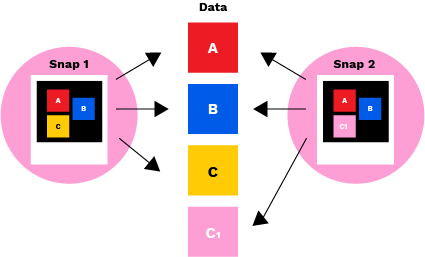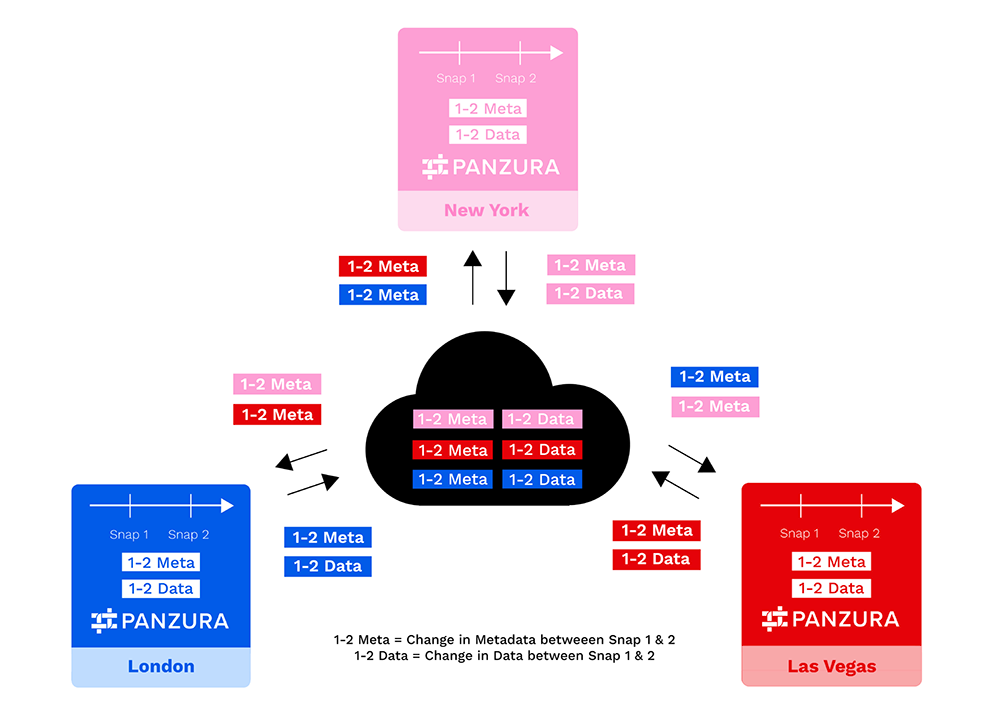- Products
- HYBRID CLOUD FILE PLATFORM
 Panzura CloudFSConsolidate file data, boost resilience and increase productivity with immediate global data delivery
Panzura CloudFSConsolidate file data, boost resilience and increase productivity with immediate global data delivery
 Panzura EdgeExtend secure, performant file access to remote and authorized external users at the edge
Panzura EdgeExtend secure, performant file access to remote and authorized external users at the edge
 Panzura Data ServicesGet complete visibility, always-on governance, and real-time global data search and retrieval
Panzura Data ServicesGet complete visibility, always-on governance, and real-time global data search and retrieval
 Panzura Detect and RescueAutomatically detect suspicious file activity in near real time and stop ransomware in its tracks
Panzura Detect and RescueAutomatically detect suspicious file activity in near real time and stop ransomware in its tracks
- DATA SERVICES PLATFORM
 Panzura SymphonyAccess comprehensive data visibility and operations under a single pane of glass.
Panzura SymphonyAccess comprehensive data visibility and operations under a single pane of glass.
-
Discover how to dramatically improve file data resilience and productivity while simplifying operations with our powerful hybrid cloud file and data services platforms.
- Solutions
- USE CASES
- Data MigrationAccelerate large-scale data migrations with metadata awareness.

- Disaster RecoveryGain resilience with data that bends but doesn’t break.

- Global File CollaborationForget delays and version conflicts across multiple sites.

- Governance & ComplianceReduce inefficiencies, streamline operations, and prevent costly mistakes.

- NAS ConsolidationEliminate data silos and endless storage refreshes.

- Zero Trust Data BrokerOptimize LLM training and performance in a zero trust environment.

- INDUSTRIES
- Architecture, Engineering & ConstructionImproving time-to-value by securing data & enhancing cross-site collaboration

- Banking, Financial Services & InsuranceDelivering financial value by driving digital transformation

- Healthcare & Life SciencesProtecting patient data, improving outcomes & powering research

- ManufacturingStreamlining workflows & improving efficiency to accelerate time to market

- Media & EntertainmentPowering secure global collaboration & reducing exponential data growth

- Public SectorProviding military-grade security & enabling advanced data compliance

- Solutions
- SOLUTIONS
- Banking, Financial Services & InsuranceDelivering financial value by driving digital transformation

- Architecture, Engineering & ConstructionImproving time-to-value by securing data & enhancing cross-site collaboration

- Healthcare & Life SciencesProtecting patient data, improving outcomes & powering research

- Media & EntertainmentPowering secure global collaboration & reducing exponential data growth

- ManufacturingStreamlining workflows & improving efficiency to accelerate time to market

- Public SectorProviding military-grade security & enabling advanced data compliance

- Resources
- Support
- CUSTOMER SUPPORT
- Global ServicesEnjoy streamlined data migration & world-class customer service.

- Service HubYou deserve the best service the industry has to offer. Get it here.

- Knowledge BaseLearn everything you need to know about Panzura products & services.

- Partner PortalAccess tools & resources designed exclusively for our channel partners.

- Support Informationsupport@panzura.com
- About
- ABOUT PANZURA
- Our CompanyWe charted a new path to the top — and it’s a hell of a story!

- Leadership TeamMeet mavericks, motivators & masterminds who drive our success.

- CareersWe’re looking for the best & brightest. If that’s you, let us know.

- Press RoomKeep up with our latest news, insights & company updates.

TECHNOLOGY DEEP DIVE
Snapshots, Backup, and Disaster Recovery
Panzura's hybrid cloud platform CloudFS™ uses immutable data and granular, immutable snapshots to make it quick and easy to restore a file, folder or the entire file system in the event of any file damage.
With a near-zero recovery point objective (RPO) and recovery time objective (RTO) of as little as minutes, this powerful and modern approach focuses on data resilience and business continuity, with no single points of failure and the ability to achieve high availability for data and users.
For IT teams currently replicating data multiple times for backups and disaster recovery in order to achieve data durability, the CloudFS approach frees up significant storage space, operational time, and dramatically improves time to recovery as well as precision of recovery.
Simplify Costly Backup and Slow Restore Processes
Enterprises using legacy NAS will often replicate data from one NAS device to a second local NAS device for high availability. They may then replicate the data again to a third remote NAS device for disaster recovery. The replicated data is typically read-only and, in the event it is needed, will require a recovery process.
Panzura CloudFS™ allows enterprises to break this cycle. Instead, they can consolidate their unstructured data in the cloud, leverage enterprise cloud data protection for geographic redundancy, and use snapshot-based restoration in place of restoring from backups.
Enterprise Cloud Data Protection
Cloud providers automatically create redundant copies of data across different data centers and geographies as part of architecting system durability into their service. Offering 13 9s or greater durability, cloud providers offer data protection beyond what individual enterprises could affordably achieve themselves. Panzura leverages these capabilities to provide enterprise customers a single source of truth to optimize backup, recovery, archive and DR workflows.
Panzura allows organizations to further boost their data durability and availability with cloud mirroring — a real time write-split between two different cloud or on-premises object stores. This provides an effective failover in the event of a cloud storage outage.
Global Snapshot Technology
Panzura makes data impervious to ransomware and other data damage by making it immutable in the object store — whether that's in the cloud or on premises — and further protecting it with immutable snapshots. These space-efficient, enterprise-class snapshots never impact performance. Any number can be taken and stored to meet an organization's retention policy. Achieve a near-zero recovery point objective (RPO) with the ability to immediately restore data from an entire file system down to an individual file.
- User-defined snapshot schedule
Snapshots can be taken on a user-defined schedule, as frequently as every second. - Configurable snapshot retention policies
Configurable retention policies let you keep snapshots as long as you need them. - Designed to avoid I/O impact
Snapshots are done using redirect on write, which means there’s no I/O impact since data blocks are never overwritten with new snapshots.

Unique, Real-time Global Consistency Means Near-Zero RPO
Snapshots for Consistency
Snapshots capture the state of a file system at a given point in time. For example, if blocks A, B, and C of a file are written and snapshot 1 is taken, that snapshot captures blocks A, B, and C to represent the file.
If someone then edits the file so that block C1 replaces C and snapshot 2 is taken, the data pointers in the snapshot file blocks A, B, and C now point to A, B, and C1. Block C is still retained but not referenced in snapshot 2. If you wanted to recover to the original state, you can restore snapshot 1, then the system will point back to A, B, and C, ignoring C1.
By using snapshots for creating and saving an ongoing series of recovery points for different stages in data’s lifetime, a consistent state of the file system can always be restored in the event of a data loss or damage.
Snapshots for Concurrency
Panzura uses differences between consecutive snapshots both to maintain file system consistency as well as to protect data in the file system. In a process called syncing, the Panzura file system takes the net changes to metadata and data between consecutive snapshots and sends them to the cloud.
The metadata portion of these changes is retrieved from the cloud by all other Panzura nodes in the configured CloudFS, where they are used to update the state of the file system and maintain concurrency (see image below).
This system updating occurs continuously across all nodes, with each node sending and receiving extremely small metadata snapshot deltas to and from the cloud in a hub and spoke configuration, using them to update the file system seamlessly and transparently.

All of the changes in data and metadata are stored and tracked sequentially in time. Should data loss or corruption occur at the local node or in the cloud, data can be restored to any previous state at which a snapshot was taken, without the need to follow a separate backup process.
The result is the Holy Grail of a global file system: a solution that requires almost no overhead and provides near real-time, continuous rapid updates across all sites.
Snapshots for Efficiency
Panzura nodes have no practical limit for user-managed snapshots. This category of snapshots allows users to recover data without IT intervention, by simply finding the desired snapshot in their inventory and restoring it. Policies around user-managed snapshots (frequency, age, etc.) are defined by IT administration.
For example, a Microsoft Windows user in New York travels to London and realizes she needs a file that she deleted 3 months ago. She directs her Windows Explorer to the local London Panzura node, navigates to her snapshot folder, and finds the date/time that corresponds to the file system view that contains the file she wants to recover. She opens that snapshot, and navigates to the file or files she needs to recover, then just drags and drops the needed file(s) into the current file system location she wants them restored to. Within minutes, she has recovered whatever files she needs and can continue with her work, all without involving anyone from IT.
For ease of use, user snapshots have been integrated with the Windows Previous Version function allowing users to right-click on any file or folder and easily restore to any previous snapshot. IT administration can dynamically change snapshot policies as needed to satisfy data retention policies, balance frequency and duration for optimal system performance and user satisfaction.
Accelerate digital transformation with a powerful hybrid cloud file platform that:
Modernizes Storage Architecture
Allows organizations to significantly reduce storage costs by consolidating dispersed file data into a unified, deduplicated, compressed, and secured data set in the cloud or on premises.
Unlocks Organizational Productivity
Enables file data to look and feel local to users and processes everywhere. It uniquely empowers users to harness their collective skills by working collaboratively, regardless of location.
Delivers Seamless Cloud File Services
Turns public or private cloud storage into a high performance, immutable global file system that flawlessly delivers file data to people, processes, and AI, and makes it resilient to damage.
Reduces Operational Complexity
Lets IT teams turn their attention to innovation with less file data and infrastructure to manage and protect, fewer storage refreshes to plan for and less worry about recovering from file damage.